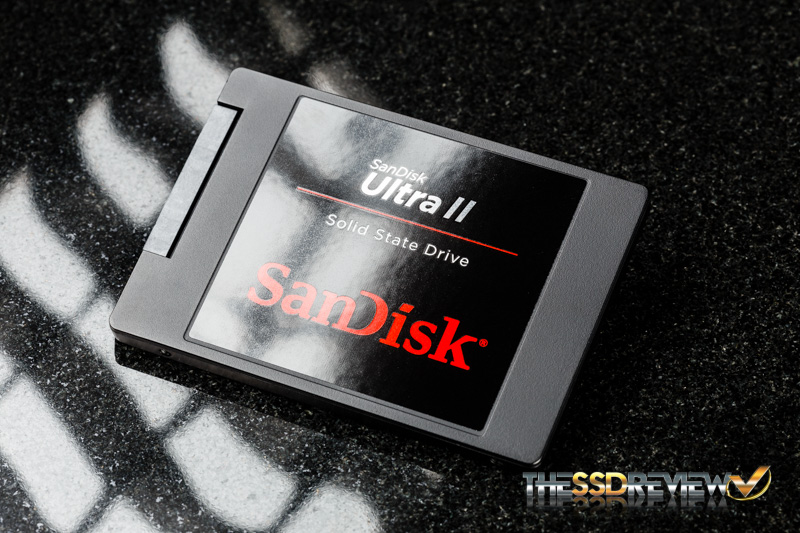SanDisk is a world leading producer in NAND flash and NAND flash products. From consumer SD cards and USB drives to OEM flash storage, SanDisk is everywhere in this market. Just a few months ago, they released their highest end, enthusiast class SSD, the Extreme Pro. It came in the market and offered some of the best SATA 3 performance we have seen and an unprecedented 10 year warranty at the time. Now, SanDisk is focusing on the mainstream consumer market with the release of their Ultra II series SSD.
Following the market trend of offering higher capacity while continuing cost reduction, SanDisk’s Ultra II is their first TLC memory equipped SSD. As we all know, 3-bit TLC NAND has some disadvantages when compared to 2-bit MLC, slower speeds and a lower program/erase cycles. To combat this, SanDisk has programs in their nCache 2.0 technology that utilizes a two-tiered caching architecture to optimize drive speed and endurance.
SANDISK ULTRA II SPECIFICATIONS, PRICING, AND AVAILABILITY
It comes in an ultra slim 2.5-inch 7mm form factor and the typical features such as S.M.A.R.T., TRIM, and NCQ are supported. More advanced features include volatile and non-volatile tiered caching, multi-stream support which improves user experience in multitasking systems, and minimal write amplification that increases endurance and performance. Advanced flash management features to note include nCache 2.0, multi-page recovery, XOR recovery, dynamic and static wear-leveling, bad block management, and background garbage collection.
nCache 2.0 is a non-volatile write cache feature that essentially makes a portion of the TLC NAND to function as SLC NAND to increase the drives performance. First data is written to the pseudo-SLC NAND. Then it uses a new DMA like folding mechanism that allows efficient data transfer via the NAND’s “On Chip Copy” feature to fold the pseudo-SLC NAND blocks into TLC blocks. The TLC blocks are then written sequentially to optimize write amplification. The copy operation is all done inside the NAND without the need to use the controller or DDR.
Furthermore, SanDisk is using multi-page recovery helps to combat the inherent program errors that are associated with TLC NAND data integrity.
The SanDisk Ultra II available capacities are 120GB, 240GB, 480GB, and 960GB. Prices are $79.99, $114.99, $219.99, and $429.99 respectively. As shown in the graph above, the Ultra 2 series drives are rated for up to 550MB/s read and 500MB/s write speeds. 4K performance ranges from 80,000 IOPS to 99,000 IOPS. As for the warranty, SanDisk is backing the Ultra II with a three year warranty.
SANDISK ULTRA II SOFTWARE
There is also new software that comes with the new SanDisk drives; it is called the SanDisk SSD Dashboard. It allows you to monitor the performance, manual or scheduled TRIM, available firmware updates and tips on how to maintain the drive at its peak operation. Users can choose from 17 different languages and get assistance from “Live Chat” and “Ask a Question via Email” buttons. Other software features include cloning by Apricorn, Trend Micro™ Titanium™ Antivirus+, and Absolute Lojack, a security by Absolute Software.
 The SSD Review The Worlds Dedicated SSD Education and Review Resource |
The SSD Review The Worlds Dedicated SSD Education and Review Resource | 


> write speeds dropped to around 240MB/s. This is still pretty good,
especially considering it is such a compact design with only four TLC
NAND packages.
I wonder how other capacities perform. This kind of write is avarage at best, since even older 840 topped that.
But, if this is priced right, its a great alternative to MX100. Lets just hope this thing doesn’t have the same issues as 840 and 840EVO, as those drives experince quite a drop in read performance on cold files. Its actually an issue, that many have nowdays.
I wonder as well. And yes, I believe this drive is a great alternative to the MX100.
I have taken note of the 840 cold files issue when it first appeared as well, it is a little disappointing. Hopefully a simple F/W update can fix it. Otherwise, I am pondering if it could be a TLC NAND cause.
I suspect (again, i’m only making wild guesses here) it has to be TLC, since its only limited to 840/840evo, while 840pro is not affected. Given how many states TLC must hold and very small litography its quite possible, that data retention is dropping faster than we though. Or it could be something entirely different.